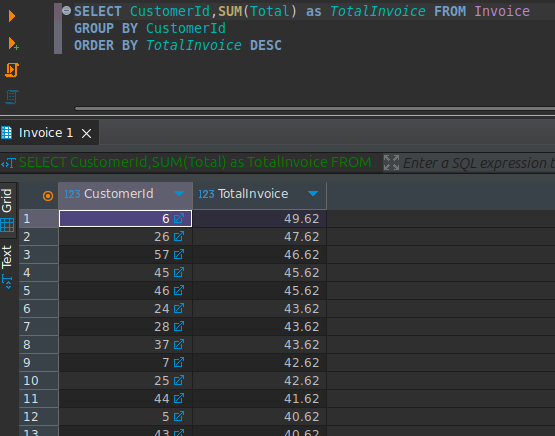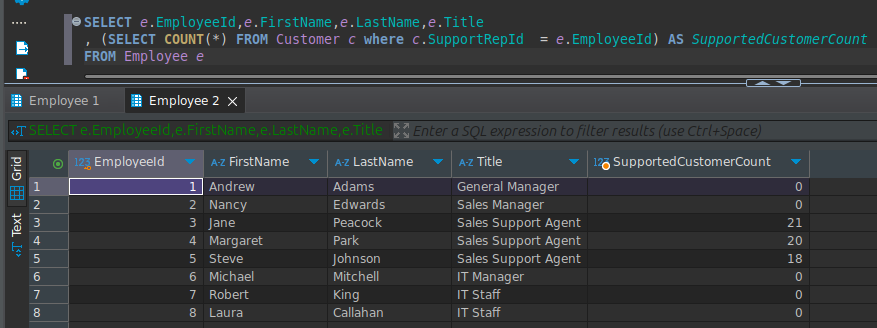36 SQL Subqueries
36.1 Subquery single value
If a query returns only a single value, we could use this as subquery in sql staments where we would use a scalar value.
Example 1
Lets say, we would like to find second largest invoice in our system. We could write below two queries to find this information
SELECT MAX(Total) FROM InvoiceThis would return value of 25.86. That is largest invoice. Using this we could write following query to find second largest invoice.
SELECT MAX(Total) FROM Invoice
WHERE Total < 25.86With this query, we get our second largest invoice total as 23.86.
But we could write this two queries as one query. Since we are using < operator, we could first query as subquery in the second query. In the second query, we replace invoice total of 25.86, with parentheses and put first query inside them.
SELECT MAX(Total) FROM Invoice
WHERE Total < (SELECT MAX(Total) FROM Invoice)This query will bring us same information as before.
36.2 Subquery list of values
For IN operator which expect list of values , we could use also sub queries. These type of queries, sometimes replace joins for more readable versions.
I would like to know top 10 customers who are making the most purchases.
First lets write two query version and change it to sub query.
SELECT CustomerId,SUM(Total) as TotalInvoice FROM Invoice
GROUP BY CustomerId
ORDER BY TotalInvoice DESCThis gives me following result.

I could copy paste, customer id values and put them in a list, like following.
(6, 26, 57, 45, 46, 24, 28, 37, 7, 25)
Then I could use this list in a second query.
SELECT * FROM Customer c WHERE c.CustomerId IN (6, 26, 57, 45, 46, 24, 28, 37, 7, 25)But we could also, write this one in sub query. First query will be inputted to second query IN(). We also modify first query to use limit so that only top 10 customers will be shown.
SELECT * FROM Customer c WHERE c.CustomerId IN (
SELECT CustomerId, SUM(Total) as TotalInvoice FROM Invoice
GROUP BY CustomerId
ORDER BY TotalInvoice DESC
LIMIT 10
)Well, if we run this query, we get following error.
SQL Error [1]: [SQLITE_ERROR] SQL error or missing database (sub-select returns 2 columns - expected 1)Our first query returns 2 columns but IN expects only one. We could change our first query so that it returns only customer id in following way. We do not have to also select SUM(Total), we could only use it ORDER BY like following sql.
SELECT CustomerId FROM Invoice
GROUP BY CustomerId
ORDER BY SUM(Total) DESC
LIMIT 10Then, our complete query will be following.
SELECT * FROM Customer c WHERE c.CustomerId IN (
SELECT CustomerId FROM Invoice
GROUP BY CustomerId
ORDER BY SUM(Total) DESC
LIMIT 10
)36.3 Subquery for column in select
We could also write a subquery in select statement. Then our subquery will be run for every row in our result. This could be used to replace a join with a subquery.
**Example 1*
We would like to show Employee information together with how many customer they support. Same way, lets start with two queries and then combine them in sub-query way. s
SELECT E.EmployeeId,e.FirstName,e.LastName,e.Title FROM Employee e Second query will be to find customer count.
SELECT * FROM Customer c where c.SupportRepId = 3This query gives us every column in Customer table but we need only count.
SELECT COUNT(*) FROM Customer c
where c.SupportRepId = 3Okay, lets put this into first query.
SELECT e.EmployeeId,e.FirstName
,e.LastName,e.Title
, (SELECT COUNT(*) FROM Customer c
where c.SupportRepId = 3) AS SupportedCustomerCount
FROM Employee e 
Supported customer count is 21 for all of the rows. This is normal since we are using c.SupportRepId = 3 in our where clause. Lets replace that one with EmployeeId from outer query. That is c.SupportRepId = e.EmployeeId
SELECT e.EmployeeId,e.FirstName
,e.LastName,e.Title
, (SELECT COUNT(*) FROM Customer c
where c.SupportRepId = e.EmployeeId) AS SupportedCustomerCount
FROM Employee e 
36.4 Sub-query FROM
This is the most powerful form of sub-query. We could use sub-query where we would write a FROM statement.
simple example 1
SELECT * FROM
(
SELECT * FROM Customer c
WHERE c.Company IS NULL
)We are selecting Customers who has no company. This is very simple example but shows the usage. We could write almost any query between the parentheses and treat query result like view or virtual table.
** simple example 2 **
In the below query, we use self join in Employee table to find Employee and their manager information together. Then we filter this result set to find those employees whose Manager Last Name start with ‘A’.
SELECT * FROM
(
SELECT E.EmployeeID
,E.LastName AS EmployerLastName
,E.FirstName AS EmployerFirstName
,E.ReportsTo
, M.EmployeeID as ManagerID
, M.LastName AS ManagerLastName
,M.FirstName AS ManagerFirstName
FROM Employee E
INNER JOIN Employee M
ON E.ReportsTo = M.EmployeeID
)
WHERE ManagerLastName LIKE 'A%'